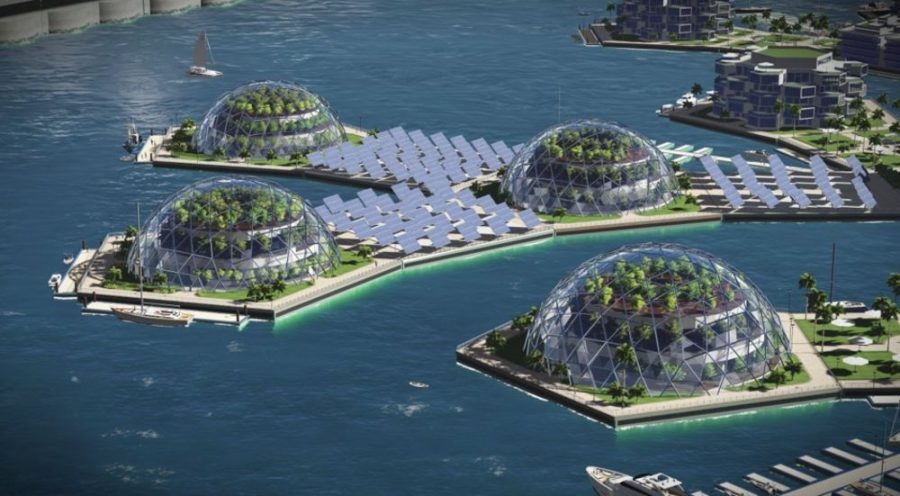Land, No!
Courtesy of the Seasteading Institute
A digital artist’s rendering of a potential floating city.
January 15, 2021
Earth is currently facing the COVID-19 pandemic, many environmental problems, and corrupt governments worldwide. However, the Seasteading Institute offers a solution: going out into the high seas and building a floating nation. The Institute’s team of ‘aquapreneurs’, called the Ocean Builders plan on sustainably practicing seasteading. The team designs permanent living spaces in international waters, away from the problems of civilization. Like many other seasteaders, the past year has motivated them to carry out their plans and they have scheduled upcoming projects in the nearest future.
Seasteading is an interesting option that some developers have turned to lately, albeit it was always around. The idea of structuring aquatic cities is not a novelty idea. Infact, prehistoric Celts have been building crannogs in marshes during the Stone Age and the ancient Mesoamericans have been forming chinampas for agricultural purposes. Seasteaders are also inspired by Venice and Dubai’s man-made floating structures. More recently, countries like China and Panama have been establishing offshore artificial islands. Some even have differing economic and trade laws than the mainland and have proved to be profitable. Some man-made isles can house communities and can potentially sustain a permanent population. The building techniques that some seasteading organizations look into are those of oil rigs and other platforms that have been stationed in the sea.
Seasteads could provide amenities similar to homes on land. They invest in hydroponics and aeroponics, which are processes that grow plants without using a soil or aggregate medium. Seasteaders can rely on these forms of horticulture along with water desalination equipment to obtain food and water. Some dwellings can withstand hurricanes, although they are generally built in calm seas. Designers have installed different types of waste disposal systems and decided to use regeneratable energy from solar panels. Since most seasteads are hosted by an existing nation, the seasteaders can receive goods and services from the already existing supply chains; drone deliveries could deliver materials.
Joe Quirk, President of the Seasteading Institute and co-founder of Blue Frontiers, claims that “Not only is seasteading the quickest, cheapest solution to sea-level rise, [but it will] increase the amount of life on the ocean with every seastead we build.”
Climate change-induced problems such as overpopulation and rising sea levels are some of the core problems that the Institute wants to solve. Their team builds dwellings with enough stability to allow new ecosystems to form. Their foundations foster the growth of coral reefs, which in turn, attract other marine life. This can help fight ocean depletion, albeit on a smaller scale. They craft systems of aquaculture to fix ocean acidification. Seastead platforms or pillars are built from recycled plastic that is found in the ocean; so that it benefits the habitats that environ them. Designers of seasteads want their synthetic islands to look modern while being ecologically protective.
Amid the global health crisis, contagious residents of a seastead could detach from the community and float away to a safe distance. Most island nations hardly report any cases as their health care systems deal with outbreaks differently. That is because they are not instantly overwhelmed by cases like landlocked nations. “The safest place to be in a pandemic is a seastead,” says Quirk. Advocates for seasteading saw the COVID-19 pandemic as an opportunity to build more living spaces in the sea. There are countries that are still crowded during this deadly time and seasteads sound like an answer to their housing concerns. Quirk has been developing the SeaPod, which he hopes to be an affordable alternative to a house on the mainland. Maritime countries and islands have been greatly spared from COVID-19, unlike continental nations. It is up to innovative people to discover solutions to problems that humanity faces. For now, seasteaders have to work with governments in order to reach agreements. The idea of seasteading is scalable; they gradually work their way from shallow waters near the mainland to possibly getting further away from continental shelves.
There are also micronations that boast the same ideals of freedom and independence as do the seasteaders. For instance, Sealand, a disused gunnery fort located seven nautical miles off the coast of England, claims sovereignty from the mainland. Like many seasteaders, the maritime country of Sealand is not subject to the laws of surrounding nations. Given that most land is claimed today, the sea is a frontier where people can possibly live in international waters with political autonomy. With problems such as inept politicians, seasteading promises a good solution. This libertarian’s dream can redefine governance and create alternate societies that are beyond the complete jurisdiction of sovereign nations. Seasteading offers a hope for people to peacefully oppose oppressive governments just by moving into the ocean.
However, there have been many hurdles; governments do not like to be proven obsolete and most do not believe they need an upgrade. For instance, when Giorgio Rosa claimed his own micronation in the Adriatic sea, the Italian government occupied the man-made platform and detonated it with explosives. Such was the story of the short-lived Republic of Rose Island. Another disturbing example is the couple that lived in a seastead near the coast of Thailand. They were arrested by the government for treason and obstructing shipping. The navy towed their floating home to shore and the couple nearly faced the death penalty for threatening the country’s sovereignty, which is a capital crime. Having a floating cottage in Thailand’s exclusive economic zone had nearly endangered the lives of Chad Elwartowski and Nadia Supranee Thepdet. This was especially frustrating for them since they had acquired permission from their host nation. Existing countries do not recognize artificial or man-made islands as countries, which is a problem that more future seasteaders will face. Governments will most likely try to deter seasteaders by claiming it is just a way for billionaires to escape taxes, when in reality, the wealth profile of potential residents is mainly those who make $50,000 a year or less. Most of this is a reminder as to why seasteaders want to be seasteaders in the first place.
Randy Hencken, executive director of the Floating City Project, notes that governments tend to have more freedom when they are smaller and more localized. He believes in dynamic democracy and takes aspects from startup cities to base their governance on. Inhabiting the ocean and creating new city-states more than 200 miles out is part of their mission. Many other groups that build their enterprises in the sea such as Oceanix, Blue21, and DeltaSync agree that seasteads must be financially feasible, have mobility, and match other criteria that people prefer. The seasteads would adhere to international law to have order and protections when the seasteads do not have host nations. The past year has encouraged seasteading organizations to push for their projects even more, and hopefully Quirk’s dream of seeing more seasteads before 2050 will materialize.



